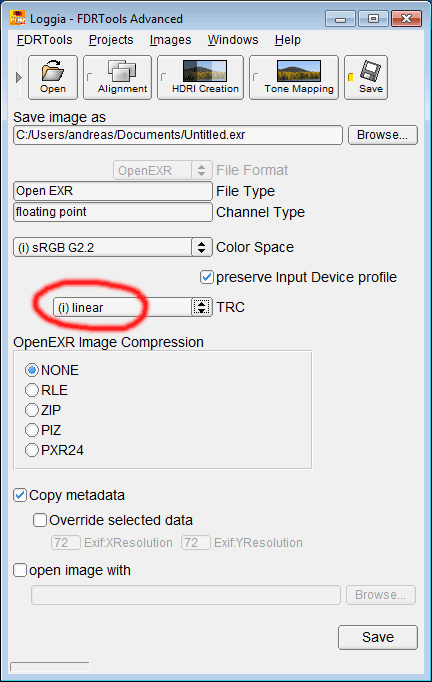
A HDR image is an attempt to reconstruct the intensities of the real scene like our eye would recognize them. An (optimal) HDR image therefore comprises the full dynamic range of a scene in uncompressed form. In general a HDR image can not be saved lossless in a 8-bit data format. Lossless storage in general requires a floating point data format.
FDRTools supports the floating point formats OpenEXR, RGBE and TIFF FP (floating point). We recommend the OpenEXR data format for the saving of HDR images.
Tone mapping compresses the dynamic range of a scene in a way that the resulting image can be saved in an ordinary 8-bit or 16-bit integer data format. Such formats like JPEG are denoted as LDR (low dynamic range) formats. The most important ones are TIFF 16-bit and JPEG. Because FDRTools is not designed to be a full-fledged image editor the resulting LDR images are in general further processed in an external image editing application. To this end it is recommended to save tone mapped images in a lossless data format.
FDRTools supports several 8-bit and 16-bit integer formats. We recommend the 16-bit TIFF format for the saving of tone mapped images.
When exiting FDRTools the projects with all relevant project details are saved automatically. When starting FDRTools again the projects are also loaded automatically again.
The results from processing a scene, namely HDR image and tone mapped image - are saved explicitly. This is done from within the project editor. By choosing one of the tone mapping modules you decide which type will be saved. Choose Identity if you intend to save the HDR image. Choose Simplex, Receptor or Compressor to save the LDR image, see Tone Mapping in FDRTools.
The Saving Image dialog is displayed by pressing the "Save" button in the task bar or by choosing the menu entry Images -> Save as...
The figure below shows the Save Image dialog. Use the "Browse" button to browse the file system and choose file path, file name and data type. The fields underneath show the parameters of the output device (for a description see FDRTools -> Preferences -> Output Device) and image format settings (for a description see FDRTools -> Preferences -> File Formats).

|
||
| Saving a result in the project editor | ||
As already mentioned the HDR image is displayed via the tone mapping module Identity. Once you have chosen Identity as tone mapper make sure the Exposure slider is set to 0. Now press the "Save" button in the task bar or choose the menu entry Images -> Save as...
HDR images should be saved as floating point data. Possible data types are: RGBE, OpenEXR and TIFF FP. Now before starting the saving there is one more thing to consider: HDR images should be saved as "linear" light. To do this set the "TRC" menu button to "(i) linear" (an alternative would be to choose a linear color profile like "(i) Wide Gamut RGB G1.0"). Now save the image. Note: saving HDR images is not interesting for the "normal" user. However, if you save HDR images on a regular basis it is recommended to create a custom Parameter Set (see FDRTools -> Preferences -> Devices) to make sure the right settings are chosen automatically.
 |
||
| Saving the HDR image |